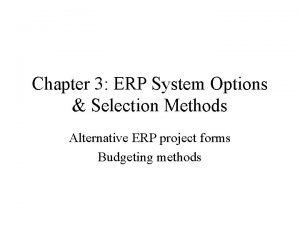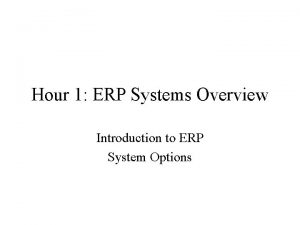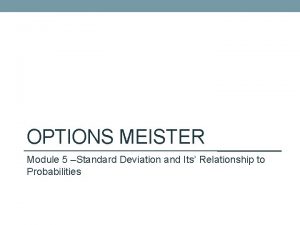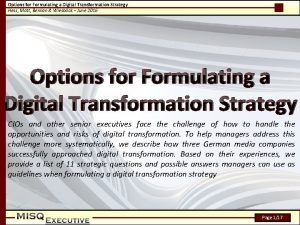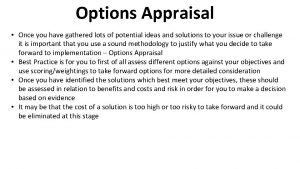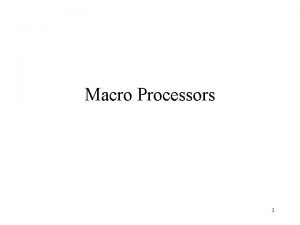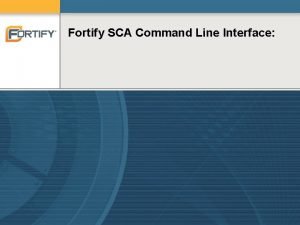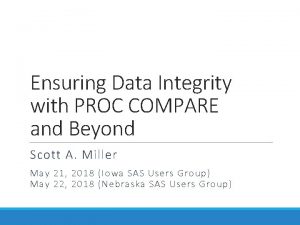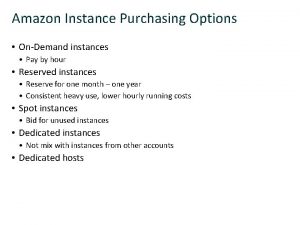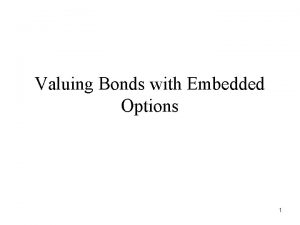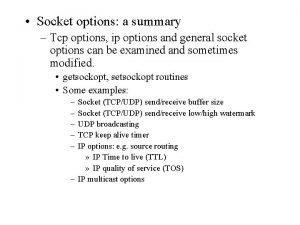Ch 3 Help and Support Options Help And



















































- Slides: 51

Ch 3 - Help and Support Options

Help And Support Center Click Start, Help and Support

Help And Support Center Tools, including – Disk Defragmenter – System Configuration Utility (Msconfig) – Network Diagnostics – Syntax and usage information for 175 command -line options Windows Update Dozens of troubleshooters (under Fixing a problem)

Help And Support Center (continued) Computer Information Easy access to – error logs – Group Policy settings Links to external information sources, including the Microsoft Knowledge Base Remote Assistance

Using the Help And Support Center Searching for Help Topics Results are in three groups – Suggested Topics – Full-Text Search Matches – Microsoft Knowledge Base Using the Help Index

Connecting to Another PC with Remote Assistance The novice sends a Remote Assistance invitation – Using Windows Messenger, e-mail, or a shared file The expert accepts the invitation The expert can view the desktop and exchange messages with the novice using text or voice chat. If the novice grants permission, the expert can work with objects on the remote PC

RA Ticket At the heart of each Remote Assistance connection is a small text file called an RA ticket. rc. Buddy. Ms. Rc. Incid ent

Remote Assistance and IP Addresses A Remote Assistance connection is easy when both parties have public IP addresses -- the computers connect directly, using TCP port 3389 (and port 80, if you use Messenger) Remote Assistance connections are also easy on a private network – the computers connect without having to pass through any routers.

Remote Assistance and NAT If one or both sides of the connection are using private IP addresses assigned through Network Address Translation (NAT), there can be trouble connecting Internet Connection Sharing – Internet Connection Sharing (ICS) from Windows XP or Windows Me automatically lets Remote Assistance through – Older routers are harder to configure for

Sending a Remote Assistance Invitation From Help and Support Center, click on – Invite a friend to connect to your computer with Remote Assistance

Maintaining Security Set a short expiration time on Remote Assistance invitations sent via e-mail. A time of 1 hour should be sufficient for most requests. Assign a strong password to Remote Assistance invitations. Manually expire invitations when they’re no longer needed.

Disabling Remote Assistance Open System in Control Panel Click the Remote tab Clear the Allow Remote Assistance Invitations To Be Sent From This Computer check box. Note: Remote Assistance uses port TCP port 3389 (and port 80 if you use Messenger)

Other Support Resources In Help and Support Center, click the Support button for – Windows Newsgroups – Microsoft Support

Chapter 4 - Installing, Uninstalling, and Managing Programs

How User Rights Affect Program Setup Options Administrator account – Can install any program without restrictions – Can also choose to remove, modify, or repair that program at any time – Therefore, spyware and viruses can be installed if you use the Internet while logged in as and Administ Limited user account – Blocked from installing most programs

Power Users can install most programs, but not modify system files – The Power Users group is on the list of default groups in Windows XP Professional, but it has no members by default – It’s not much safer than using an administrative account

Run As Temporarily elevates privileges – Right-click a file, sometimes Shift. Right-click Much safer for security – Best practice is never to be logged in as an Administrator, if you can manage it

Installing a program for a user with a limited account Windows 9 x applications can stumble in Windows 2000 and Windows XP. – Is an upgrade available? – Is there a published workaround? – Can you adjust permissions in the registry? – Temporarily "promote" the user – Find a Windows XP–compatible program

Installing Programs Before installing a new program, ask the following questions: – Is it compatible with Windows XP? – Are any patches available? – Are there known problems with the program? – Can it be uninstalled easily? Set a restore point first – Start, Help, System Restore

Installing 32 -Bit Windows Programs Virtually all modern 32 -bit Windows programs start the Setup process through a file called Setup. exe – Windows can track down the proper Setup file automatically when you use Add Or Remove Programs

Assigned and Published Applications Windows Installer lets administrators configure a program so that it installs automatically from the server, in a domain Three techniques – Assigned to a user Appears on Start menu, installs on first use – Assigned to a computer Installs on boot-up – Published User can install from Add New Programs window.

Installing and Running 16 -Bit Windows Programs – To run these older 16 -bit programs Written for DOS or Windows 3. 1 – Windows XP launches a subsystem—a virtual machine —that mimics "386 enhanced mode" in the older Windows 3. x environment.

Glitches in 16 -bit programs Usually do not support long file names. Do not run as fast Require 16 -bit device drivers, which are not supported in Windows XP May have trouble with Dynamic link libraries (DLLs)

How to spot a 16 -bit application Right-click the program’s executable file and then choose Properties. If you see a Version tab, it’s a 32 -bit program Task Manager will show Ntvdm. exe, the virtual DOS machine, when 16 -bit apps are running (example -- C: WindowsWinhelp)

Multiple 16 -bit Apps in a single virtual machine By default, Windows XP treats each running 16 -bit application as a thread within a single virtual machine. – If you just launch Winhelp 3 times, you get these processes

Multiple virtual machines To make 16 -bit apps more stable, do this: – Create a shortcut to the program, right-click the shortcut icon, and then choose Properties. – On the Shortcut tab, click the Advanced button. – Select the Run In Separate Memory Space check box. This approach uses extra memory.

COMMAND vs. CMD Command. com, the MS-DOS command processor, is a 16 -bit application included with Windows XP – If you type command in the Run box, Windows starts a new MS-DOS virtual machine Cmd. exe is the 32 -bit Windows XP Command Prompt program. – For most command-line tasks, Cmd is preferred.

Making a Program Available to All Users Most of the time, when you install a Windows program from an administrator’s account, its shortcuts are placed in the All Users profile – %All. Users. Profile%Start MenuPrograms – Usually C: Documents and SettingsAll UsersStart MenuPrograms So that any user who wants to run that program can do so.

Making a Program Available to All Users If Setup installs a program only for the currently logged-on user, you have two choices: – Log on using each user account and rerun Setup – For simple programs that don’t require peruser settings to be added to the registry before running, you might be able to simply add a shortcut to %All. Users. Profile%Start MenuPrograms.

Forcing Older Programs to Run Properly Make a program shortcut. Right-click the shortcut icon and choose Properties, and then click the Compatibility tab

Managing Installed Programs Control Panel, Add Or Remove Programs

Uninstalling Programs Add Or Remove Programs in Control Panel – Lists installed programs in alphabetical or by date last used – Most uninstall programs leave at least a few traces of the program behind

Running a Program as Another User If you’re logged on using a limited account and the program you want to use requires administrative privileges, you have three options: – Fast User Switching (not available on a domain) – Right-click, Run As (sometimes Shift-rightclick) – Runas command from a command window runas /user: username cmd

Run With Different Credentials To make it ask for credentials every time, right-click the shortcut icon and choose Properties. On the Shortcut tab, click the Advanced button and select the Run With Different Credentials check box.

Chapter 5 - Setting Up and Troubleshooting Hardware

Device Drivers Windows needs a driver for each device – Drivers are programs that hook directly into Windows, send your instructions to a hardware device, and relay data back to you.

Plug and Play Drivers All the Plug and Play (Pn. P) drivers are in Driver. cab – in %System. Root% Driver Cachei 386 – Each Pn. P driver has a Setup Information file (with the extension. inf) in %System. Root%Inf

Driver Signing A digitally signed driver is best, because it shows – The driver was tested and approved by Microsoft – The driver was not modified In its default settings, Windows XP warns you if you’re attempting to install a driver that isn’t digitally signed. – An unsigned, faulty driver can cause crashes, including blue-screen errors

Configuring Driver Signing Control Panel, Performance and Maintenance, System, Hardware tab. Click the Driver Signing button. There are three choices: – Ignore, Warn, Block

Will Drivers Written for Other Windows Versions Work with Windows XP? Many (but not all) Windows 2000 drivers will work in Windows XP. – Windows Me drivers might also work under Windows XP, but only if the accompanying Setup Information (. inf) file includes specific instructions for Windows 2000/XP. – Drivers originally written for Windows 95/98 or Windows NT 4 or earlier are unlikely to work

Plug and Play Requirements BIOS must support Pn. P (all ACPI BIOS’s do). OS must support Pn. P (Win XP does). Device must be Pn. P-compatible – If it shows the Microsoft "Designed for Windows" logo, it does. The device driver must support Pn. P – Note: You must be logged on as a member of the Administrators group to install hardware drivers.

Configuring Non-Plug and Play Devices Control Panel, double-click the System icon, click Add Hardware Wizard button on the Hardware tab. You can choose a driver from a list, provide it as a file, or check Windows Update for it

Device Manager To Open Device Manager – Right-click My Computer and select Manage – From a command prompt, enter devmgmt. msc – From Control Panel, double-click the System icon and click the Device Manager button on the Hardware tab

Device Manager – To view information about a specific device, double-click it General tab Driver tab Other tabs for some devices

View devices over the network In Computer Management, select the Computer Management icon at the top of the left pane, and choose Action, Connect To Another Computer.

Troubleshooting Resource Conflicts Resources are allocated automatically at startup, and cannot normally be changed in Device Manager With PCI devices, try swapping cards, two at a time, between PCI slots. Replace legacy (ISA) devices with a Plug and Playcompatible PCI devices Use jumpers or a software utility to change settings on a legacy device so that it reserves a different set of resources Check for an updated hardware driver (especially if the current driver is unsigned) and look for a BIOS update as well

Managing Installed Drivers Your first stop should be Device Manager Open the Properties for the device, Driver tab – Update Driver. – Roll Back Driver. – Uninstall

Driver Verifier Will test your drivers the way they Microsoft Logo program does, and stop your machine at startup with specific information if a driver fails the tests – Not for everyday use; but may help when you have stability problems (see p. 154155)

Enabling and Disabling Specific Devices Device Manager, Properties for the device, General tab, Device Usage setting; Use This Device (Enable) Do Not Use This Device (Disable). The drivers for a disabled device remain available, but Windows does not load them. This is useful with hardware profiles, such as with notebook computers attached to docking stations

Hardware Profiles To work with hardware profiles, open the System icon in Control Panel, click the Hardware tab, and then click Hardware Profiles.

Decoding Hardware Errors When Windows encounters a problem with a device or its driver, it changes the icon in Device Manager and displays an error code on the General tab of the device's properties dialog box. See chart p 201 -204, or Microsoft Knowledge Base Article 310123
 Community support options
Community support options Self directed support options
Self directed support options Major support and minor support
Major support and minor support Education through self help is our motto
Education through self help is our motto Help us help you
Help us help you Help im being oppressed
Help im being oppressed Helper chapter 1
Helper chapter 1 My mother makes me chicken
My mother makes me chicken Asl unit 2
Asl unit 2 Systems analysis and design in an age of options pdf
Systems analysis and design in an age of options pdf Erp selection methods and criteria
Erp selection methods and criteria Read the paragraphs below
Read the paragraphs below Options futures and risk management
Options futures and risk management Options futures and other derivatives
Options futures and other derivatives Forward vs option
Forward vs option Traders in financial futures
Traders in financial futures Currency futures
Currency futures Options on stock indices and currencies
Options on stock indices and currencies Tailing the hedge
Tailing the hedge Introduction to erp systems
Introduction to erp systems How quickly did things get out of hand in salem
How quickly did things get out of hand in salem Policyrules
Policyrules Standard deviation options
Standard deviation options Far out of the money options
Far out of the money options Options for formulating a digital transformation strategy.
Options for formulating a digital transformation strategy. Options appraisal template
Options appraisal template Global operations strategy options
Global operations strategy options Molina healthcare eligibility washington
Molina healthcare eligibility washington Internet-based wan connectivity options
Internet-based wan connectivity options Thinking routine step inside
Thinking routine step inside Macro processor design options
Macro processor design options Design of an absolute loader
Design of an absolute loader Wan transport technologies
Wan transport technologies Engagement options
Engagement options Long-term euro-btp futures
Long-term euro-btp futures Tiziana ferrari
Tiziana ferrari Options fashion distribution
Options fashion distribution Listen and circle the correct option
Listen and circle the correct option Chapter 3 food service career options worksheet answers
Chapter 3 food service career options worksheet answers Benefitoptions.az.gov
Benefitoptions.az.gov Put options
Put options Gdn targeting options
Gdn targeting options Option hacker keene
Option hacker keene Postsecondary education options
Postsecondary education options Ipers retirement options
Ipers retirement options Wewelogin
Wewelogin Options-based planning
Options-based planning Fortify command injection
Fortify command injection Proc compare
Proc compare Gap option
Gap option Ec2 instance purchasing options
Ec2 instance purchasing options Effective duration formula
Effective duration formula










